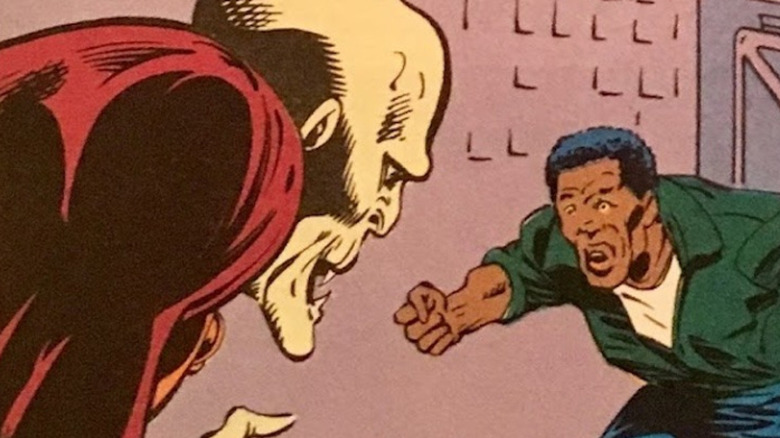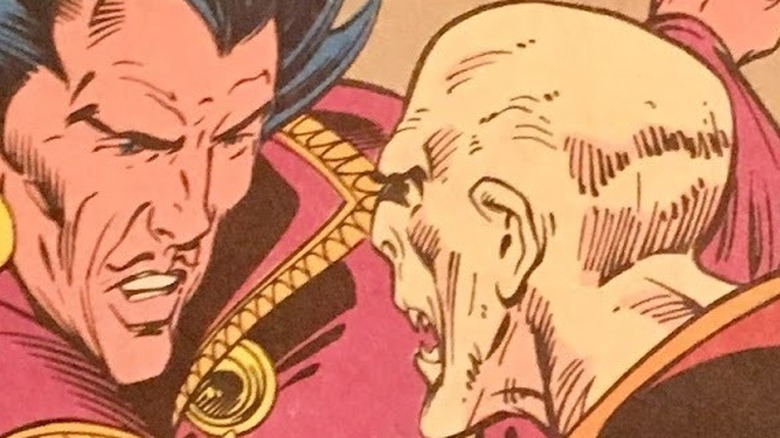Hemo-Goblin: The Infamous DC Comics Villain Explained
Death is flexible in superhero comics, and the DC Universe's regular reboots allow for easy excuses for writers to bring back long-dormant heroes and villains. And with nearly a century of DC comics to look to, those writers have a deep bench to draw from. It's telling, then, that nobody has ever attempted to bring back The Hemo-Goblin, the antagonist of "New Guardians" #1 by Steve Englehart, Joe Staton, and Mark Farmer.
Some context, for those who've forgotten this DC failure from 1988. "New Guardians" was a spin-off series from the same creative team's "Millennium" crossover event. The titular superhero group consisted of people from around the world who were chosen by Guardians of the Universe Herupa Hando Hu and Zamaron Nadia Safir to shape the future of human evolution. In this Comics Code-unapproved series, this means a lot of awkward sex talk about which characters will "breed" with each other.
The series also featured a lot of awkward attempts at topicality, of which Hemo-Goblin is among the most ham-fisted and offensive. This villain was a vampire created by white supremacists for the purpose of killing all Black people in South Africa by spreading HIV. He attacked several members of the New Guardians, only to die off-panel from the way that AIDS affected his accelerated metabolism. From that description alone, you can understand why DC is in no rush to revive this long-forgotten character.
Hemo-Goblin might have infected DC's first gay superhero
Before his sudden passing, the "AIDS vampire" bit Jet — the Jamaican-British New Guardian with electromagnetic powers — and scratched Extraño — the magic-powered Peruvian New Guardian and, arguably, DC's first gay superhero (he was never allowed to directly state his sexuality, but was obviously coded as a flaming stereotype). Jet tests positive for HIV in "New Guardians" #3, and in "New Guardians" #6, she dies fighting off an alien invasion. Fellow New Guardian Harbinger felt all of the physical damage Jet took and feared she, also, would develop AIDS, but her powers were able to overcome the disease.
Extraño also ended up testing positive for HIV, but it's vague whether he got it from the vampire attack or through the more typical ways the virus spreads. The comics' editors were inconsistent on this matter, likely retconning it to the latter after realizing how dangerous it was to imply HIV could spread through a mere scratch. The game of telephone has led to the somewhat widespread misassumption Extraño died from AIDS, but he actually remained asymptomatic throughout the "New Guardians" series, and his death was never actually shown in any of DC's comics. His last appearance in the New Earth continuity was being rescued from Entropy along with the rest of his team in "Green Lantern" Vol. 3 #35 from 1993.
Hemo-Goblin wasn't the only edgelord-y New Guardians villain
The white supremacist AIDS vampire was the "New Guardians" series' first example of turning serious topical issues into absolutely ridiculous supervillains. But while he might have been its most over-the-top, he certainly wasn't the last. Indeed, the second issue introduced perhaps the most infamous enemy of the New Guardians: Snowflame, a supervillain who uses cocaine to give himself fire powers, super strength, and super speed. There has never been a more '80s character ever published. Like Hemo-Goblin, he also died in the same issue he was introduced, blowing up in a chemical shed.
Snowflame was eventually reintroduced into DC's Prime Earth continuity in "Catwoman" Vol. 5 #23 in 2020 and has since appeared in the 2023 Black Label miniseries "Peacemaker Tries Hard!" and a few episodes of the "Harley Quinn" and "Kite-Man: Hell Yeah!" animated series. An openly gay, less stereotypically portrayed version of Extraño was introduced post-DC Rebirth in the 2016-2017 "Midnighter and Apollo" miniseries. Jet was resurrected as the leader of the Global Guardians in 2006's "One Year Later" event. To date, however, Hemo-Goblin has had no such luck and remains a DC history footnote.


